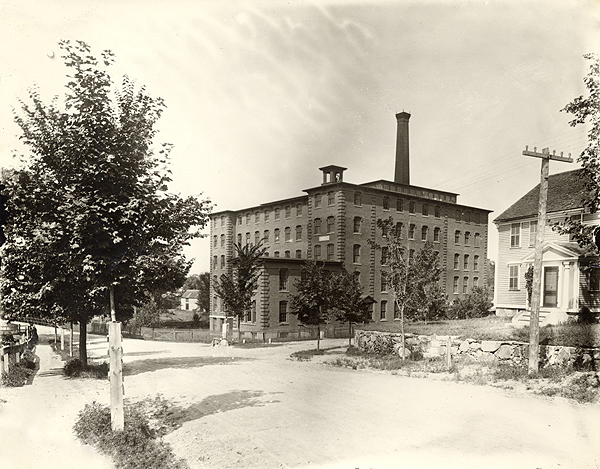

11. Rebuilding Damon Mill, 1862-1864
Though the original wooden structures burned to the ground in 1862, within a few months the mill began to rise rebuilt and transformed. Edward Damon commissioned Worcester-based architect Elbridge Boyden (1819-1896) to design the new building. Primarily a designer of commercial and government buildings, Boyden had a national reputation. His work included Mechanics Hall and portions of the Polytechnic Institute of Worcester.
Like Concord’s Town House, the new Damon Mill was designed in the Italianate style popular during the mid- to late nineteenth century. The main complex consists of eight attached sections that range from one to six stories in height and are constructed of locally-produced red brick, the corners emphasized with quoins. Architectural details that identify the building as Italianate include overhanging eaves, arched windows, and the cupola that houses the mill bell. In addition to a new main building, a dye house and a large brick storage building were also constructed. New housing was built, while older buildings were moved and converted into tenement housing for mill workers. Because of the distance to the nearest shopping area, a company store was built, with only a small profit made by Damon on the goods sold.
The new mill was equipped with upgraded machinery, and began diversifying its output. More operatives were hired, and in 1865 Edward Damon employed 34 male and 26 female workers. The mill used 40,000 pounds of cotton per year and produced 556,000 yards of cloth, valued at $216,000.
Edward Damon’s decision not simply to rebuild the mill, but to do it beautifully and expansively, determined the future of the building and of Westvale. His foresight encouraged the business to grow, and in doing so to become an even more vital part of this area of Concord, while rebuilding in a classic style, as much appreciated in the twenty-first century as it was in the nineteenth, was an important decision in assuring the life of the building.
This late nineteenth century image by Concord photographer and Thoreauvian Alfred Winslow Hosmer (from the library’s collection of more than 800 Hosmer glass plate negatives) shows Edward Damon’s rebuilt mill building.